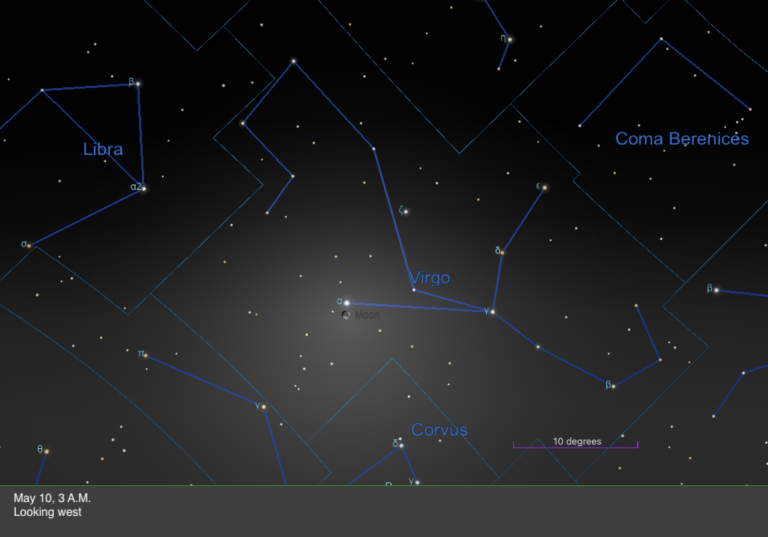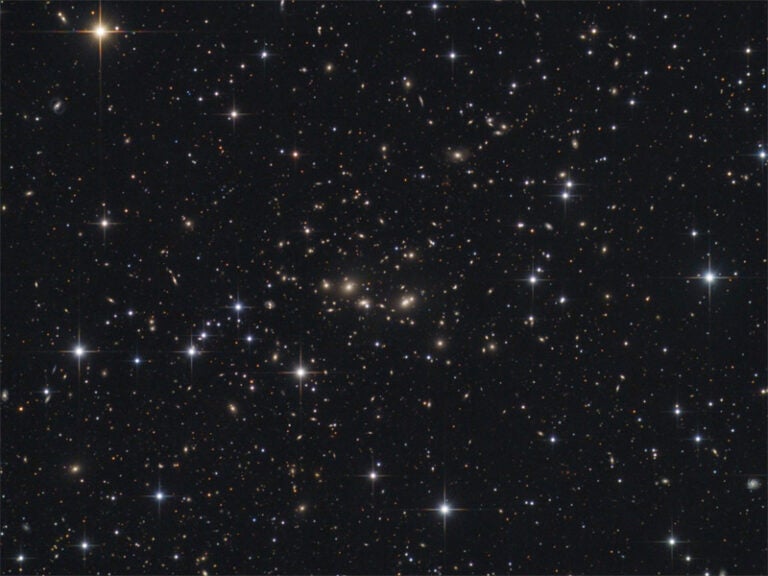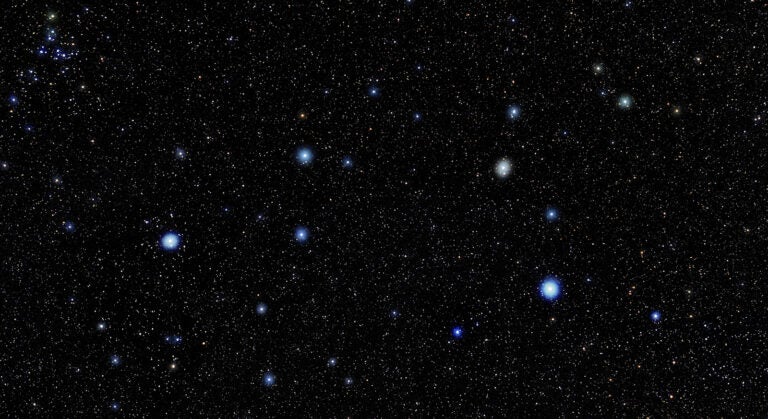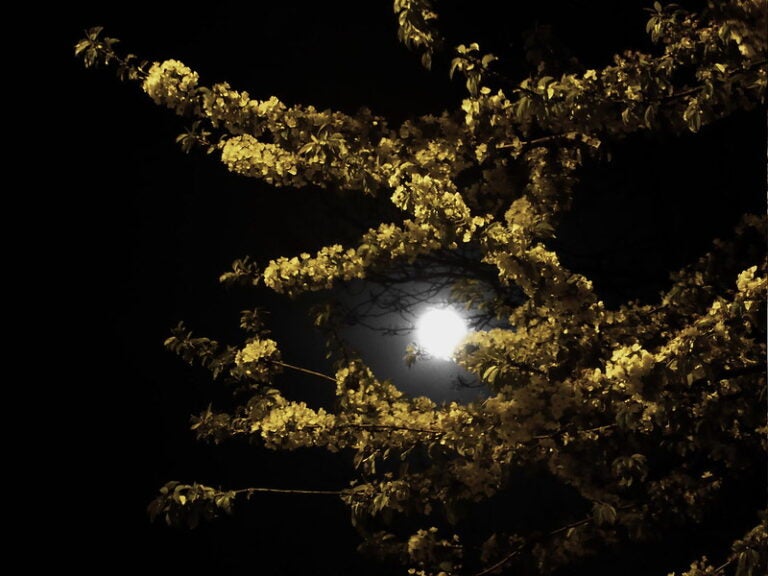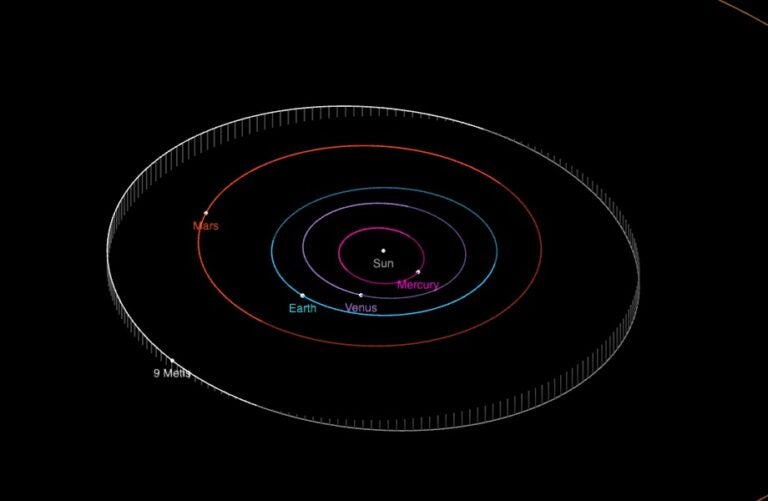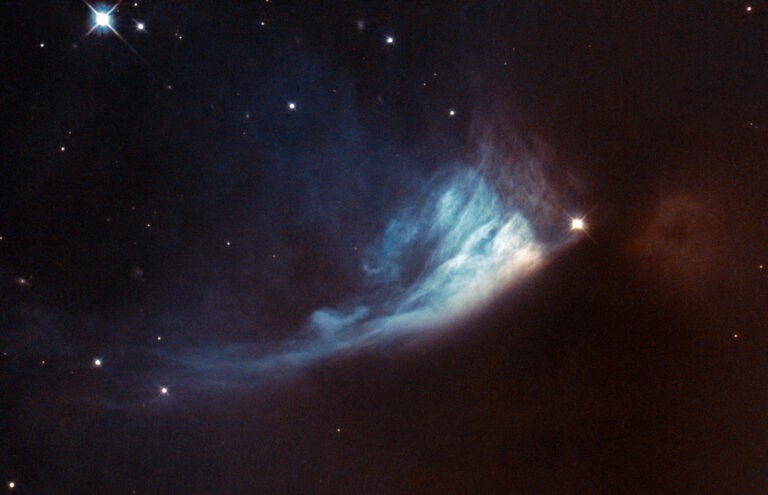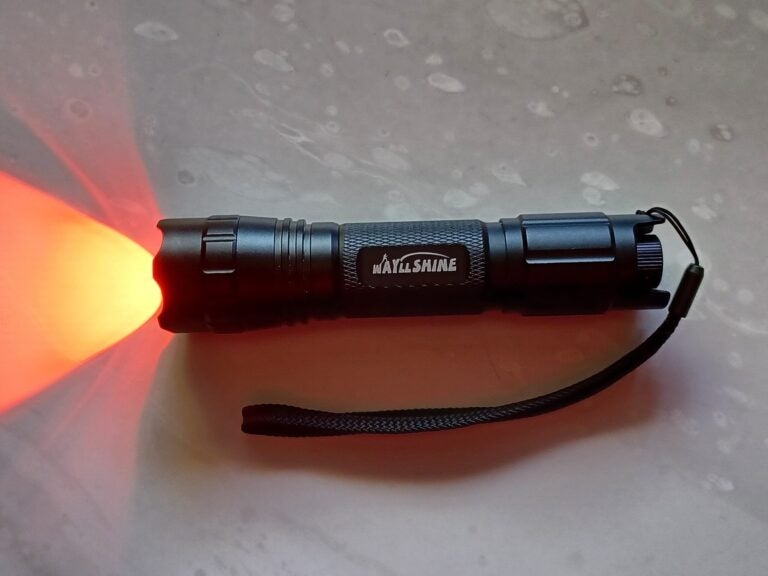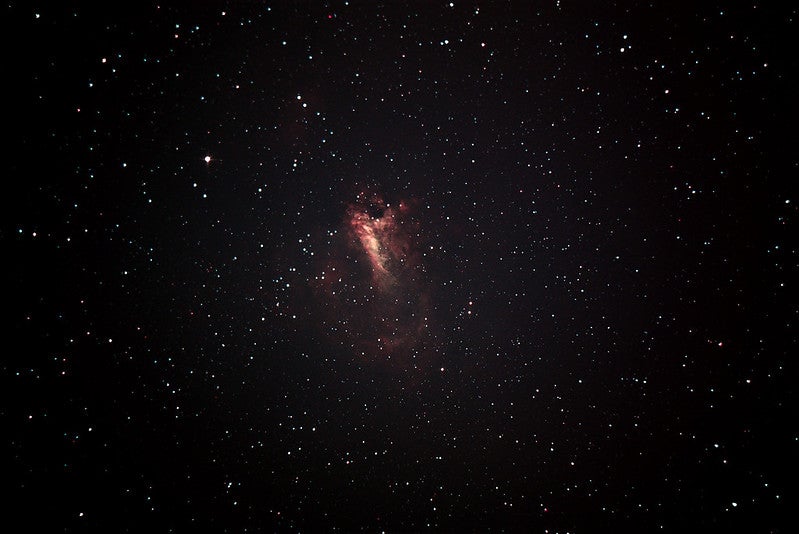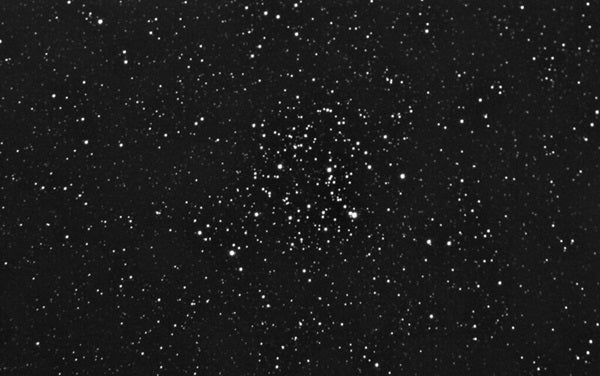
Friday, March 24
The Moon passes 0.1° south of Venus at 6 A.M. EDT, then continues along the ecliptic to pass 1.5° north of Uranus at 9 P.M. EDT. An hour after sunset, all three appear in the western sky amid the stars of Aries the Ram.
Bright Venus is a stunning evening star at magnitude –4. But let’s concentrate tonight on the close meeting between the delicate crescent Moon and Uranus, floating some 6.7° above (east of Venus) in the nighttime sky.
Uranus glows a dim magnitude 5.9 and you’ll need binoculars or a telescope to easily pick out the distant ice giant just south of a 14-percent-lit lunar crescent. The planet sits very close (within 4′) to a 7th-magnitude field star that will pop out in your optics to Uranus’ southeast. The planet is slightly brighter — note that its disk will appear more like a “flat” star than a pinprick of light, and may even display a grayish-blue coloration.
The Moon is quickly closing in on 6th-magnitude Rho (ρ) Arietis to its northeast. Some U.S. observers will catch that star disappearing behind our satellite in an occultation sometime between about 7:30 P.M. and 8:10 P.M. local time. Watch closely — do you see the star wink out, or does the Moon just miss extinguishing its light?
Sunrise: 6:57 A.M.
Sunset: 7:17 P.M.
Moonrise: 8:32 A.M.
Moonset: 10:59 P.M.
Moon Phase: Waxing crescent (11%)
*Times for sunrise, sunset, moonrise, and moonset are given in local time from 40° N 90° W. The Moon’s illumination is given at 12 P.M. local time from the same location.
Saturday, March 25
If you weren’t able to complete your Messier marathon last week, don’t worry — this weekend provides a great backup opportunity. With the Moon still a relatively slim crescent that sets just after midnight, conditions are ripe to make your way down the list of fuzzy deep-sky objects compiled by the French comet hunter.
This week, amateur astronomer Tom Polakis predicts the full list can be viewed this weekend by observers roughly between 12° and 37° north latitude. But even if you’re a bit outside that range, it’s worth giving it a go, as all but the most northerly or southerly objects should lie within your grasp.
For those who simply want an easy night of observing, let’s pick a single easy target this evening: the open cluster M93 (NGC 2447) in Puppis. Located northeast of Canis Major’s tail, this young group of stars can be found some 1.5° northwest of 3rd-magnitude Azmidi (Xi [ξ] Puppis). Spanning about 22′ and glowing at magnitude 6, this is one of the last additions personally discovered by Charles Messier for his list. It’s visible with the naked eye from a dark site, though the moonlight may interfere a bit this evening. Through binoculars or a scope, look for the cluster’s roughly triangular shape, pointing southwest. M93 contains at least 80 stars and is some 100 million years old.
Sunrise: 6:56 A.M.
Sunset: 7:17 P.M.
Moonrise: 9:02 A.M.
Moonset: —
Moon Phase: Waxing crescent (19%)
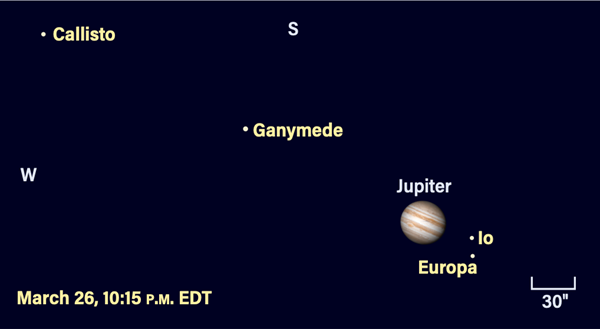
Sunday, March 26
Magnitude –2.1 Jupiter hangs close to the western horizon with magnitude –1.5 Mercury closing in. Tomorrow, the two will sit side by side above the horizon; for now, Mercury is located about 2.3° west of the gas giant, appearing to brighter Jupiter’s lower right.
We’ll be back tomorrow to enjoy both planets together, so for tonight, zoom in on just Jupiter with your telescope shortly after sunset. You’ll see it wreathed by its four Galilean moons: Ganymede (closest) and Callisto to the west, and Europa (closest) and Io to the east.
Right after sunset for the eastern half of the U.S., Europa and Io are relatively far apart. But they’re moving toward each other as Europa slides east away from the planet and Io slides west toward Jupiter, heading for a transit. Around 7:15 P.M. PDT (10:15 P.M. EDT), the two moons pass each other with Europa moving directly north of Io. West Coast observers can catch this moment as the planet sets in twilight; unfortunately, Jupiter and its moons have disappeared below the horizon for all locations farther east.
Sunrise: 6:54 A.M.
Sunset: 7:18 P.M.
Moonrise: 9:37 A.M.
Moonset: 12:08 A.M.
Moon Phase: Waxing crescent (27%)
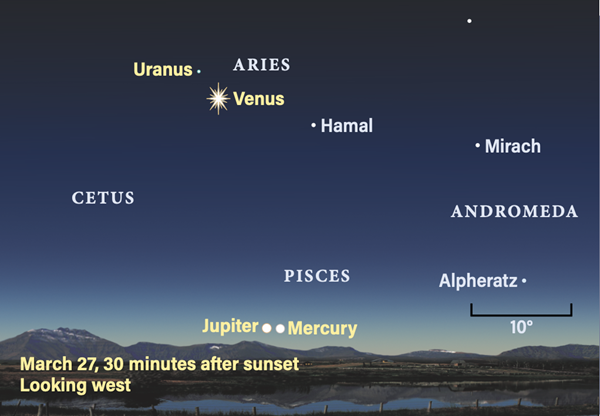
Monday, March 27
Let’s return to the western sky this evening to catch Jupiter and Mercury standing together above the horizon. Some 1.3° apart, the two are just under 4° high 30 minutes after sunset. They will quickly sink toward the ground together and set just after 8 P.M. local time. You should be able to catch them in the same field of view using either binoculars or a telescope, depending on the power of your eyepiece.
The two planets provide some significant contrast as the smallest and largest in our solar system. Look first to tiny Mercury, whose disk spans just 5″. Can you tell that its face isn’t quite full, but some 90 percent illuminated? To its southeast is mighty Jupiter, stretching 33″ across and fully lit. East Coast and Midwest observers may spot Io just off the planet’s western limb; the small moon disappears behind it just before 8 P.M. CDT and won’t reappear from Jupiter’s long shadow until after it has set even for West Coast skywatchers.
Jupiter will continue setting earlier night by night, apparently “falling” toward the Sun even as Mercury flies upward and away, growing dimmer but standing longer in the evening sky as its distance from our star increases.
Sunrise: 6:52 A.M.
Sunset: 7:19 P.M.
Moonrise: 10:17 A.M.
Moonset: 1:14 A.M.
Moon Phase: Waxing crescent (37%)
Tuesday, March 28
The Moon passes 2° north of Mars at 9 A.M. EDT, while Mercury passes 1.5° due north of Jupiter at 11 A.M. EDT. By evening, Mercury now sits to Jupiter’s upper right in the sky and the Moon appears nearly 6° directly above (northeast of) Mars. The latter two are now in Gemini and we’ll return to the Red Planet tomorrow.
First Quarter Moon occurs at 10:32 P.M. EDT, meaning the entire right (eastern) portion of our satellite is now lit by the Sun. Shadows stand out best along the terminator, which divides lunar night from day. Look for the large, round, dark blotch of Mare Serenitas in the lunar north, its western rim just touching the terminator. Closer to the limb in the northeast is the smaller Mare Crisium. And in the southeast is the bright, rayed crater Stevinus, standing out clearly against the darker terrain of the rough southern regions.
Below the Moon and Mars is the V-shaped constellation Taurus. Look for the Bull’s bright red eye, Aldebaran, as well as the famous Pleiades star cluster (M45) to its northwest (lower right). Even with the bright moonlight, these stars should be readily visible. In fact, they may stand out relatively well as the background light washes out any fainter stars nearby.
Sunrise: 6:51 A.M.
Sunset: 7:20 P.M.
Moonrise: 11:05 A.M.
Moonset: 2:14 A.M.
Moon Phase: Waxing crescent (46%)
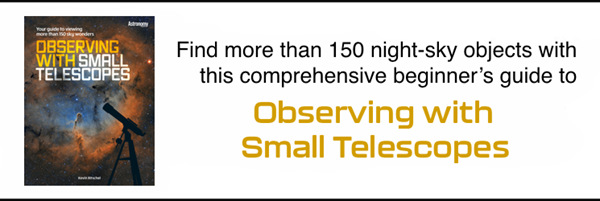
Wednesday, March 29
Look to magnitude 0.9 Mars again after sunset tonight. The Red Planet sits at Gemini’s feet, north of Eta (η) Geminorum — a position that also puts the world just over 1° due north of the open cluster M35. This 5th-magnitude cluster can oftentimes be picked out by naked eye on a dark night, though the Moon is still nearby and binoculars or a telescope will certainly show it best. Nearly half a degree across, M35 contains hundreds of stars and is a fine object to spend some time with, picking out fainter members among the numerous brighter suns.
As a bonus, M35 is accompanied by a smaller, fainter friend: Compact NGC 2158 is about 15′ to the southwest of M35. NGC 2158 is 8th-magnitude open cluster that stretches only 5′ across; it may be harder to pick out with the bright background, but give yourself some time to see if you can spot it through your scope. If you’re truly having trouble, just wait and come back in a few days, when the Moon has moved farther afield and the immediate background sky is darker.
Sunrise: 6:49 A.M.
Sunset: 7:21 P.M.
Moonrise: 11:59 A.M.
Moonset: 3:07 A.M.
Moon Phase: Waxing gibbous (56%)
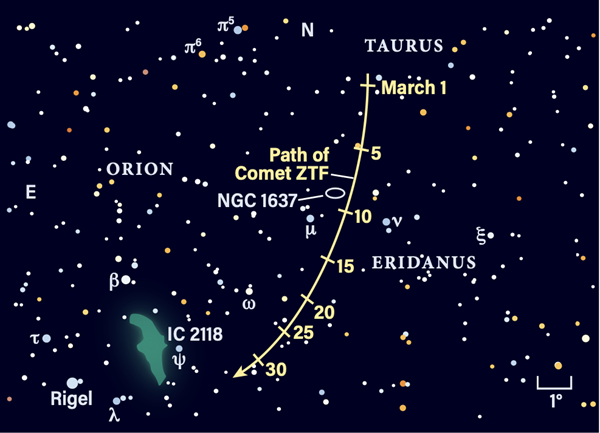
Thursday, March 30
The waxing Moon is only growing brighter, but we’re going to try our luck at a fainter target anyway, because tonight is picture perfect: Comet C/2022 E3 (ZTF) is just 3.3° from IC 2118, better known as the Witch Head Nebula.
Both are setting at sunset and sit about 25° high an hour after the Sun disappears. That provides a short but usable dark-sky window, though the earlier you’re able to hunt them down, the better. As they near the horizon, the turbulent air of Earth’s atmosphere will start to fuzz out your view. The Moon doesn’t quite help, either, but at least it’s a few constellations away!
You’ll find your quarry tonight not far from the bright star Rigel in Orion. The Witch Head is less than 3° northwest of that star, and ZTF lies west-southwest of the nebula. Aim for the comet first; it is now around magnitude 10, but its concentrated coma should offer relatively good surface brightness for you to spot it. You can use magnitude 4.4 Omega (ω) Eridani as a jumping-off point: ZTF is 2° south of this star.
You’ll need a large telescope to visually locate the Witch Head, which spans an impressive 1.5° running roughly northeast to southwest. An 8-inch scope will show the brightest portions, while an 11-inch or larger will give a much better view of the entire structure. Because the Moon is out tonight, your best bet is to capture a photograph of the region, which will pick up both the comet and the nebula better than your eyes ever could. ZTF has slowed significantly and will remain nearby for several days, though the Moon is only growing brighter as it nears Full early next month.
Sunrise: 6:47 A.M.
Sunset: 7:22 P.M.
Moonrise: 12:58 P.M.
Moonset: 3:52 A.M.
Moon Phase: Waxing gibbous (65%)
Friday, March 31
Venus passes 1.3° north of Uranus at 2 A.M. EDT. You’ll have to catch the pair in the evening, when they are just slightly farther apart — 1.8° — in the west shortly after sunset and remain in the sky for almost three hours, offering ample time for viewing. (Though as usual, the earlier, the better.)
Venus is still stunningly bright at magnitude –4, impossible to miss as it pops out early against the falling twilight. It is a waning gibbous with its disk 77 percent lit. Uranus, still magnitude 5.9, will require binoculars or a scope to pick out, especially while the sky is still light but likely even after dark as well. It lies to Venus’ lower left (south-southwest) this evening.
Slow-moving Mars is still up near M35 in roughly the same position as a few days ago. But now the Moon has moved on, so the view may be easier to enjoy.
The Moon reaches apogee, the farthest point from Earth in its orbit, at 7:17 A.M. EDT. At that time, Luna sits 251,605 miles (404,919 kilometers) away.
Sunrise: 6:46 A.M.
Sunset: 7:23 P.M.
Moonrise: 1:59 P.M.
Moonset: 4:29 A.M.
Moon Phase: Waxing gibbous (74%)


